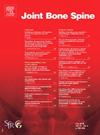Genetic background of selected hyperuricemia causing gout with pediatric onset
IF 3.8
3区 医学
Q1 RHEUMATOLOGY
引用次数: 0
Abstract
Elevated serum uric acid levels are the essential pathophysiology of gout. Although gout rarely develops in childhood, chronic persistent hyperuricemia can induce precipitation and deposition of sodium urate crystals, leading to the development of gout. Hyperuricemia is caused by increased uric acid production and/or decreased uric acid excretion capacity of the kidneys and/or intestinal tract. Increased production of uric acid, the final metabolite of purine, is associated with an increase of phosphoribosyl pyrophosphate, the key compound in the purine synthesis pathways, as observed in hypoxanthine-guanine phosphoribosyltransferase deficiency. Another mechanism for increased uric acid production is increased adenosine triphosphate consumption that is found in glycogen storage disease type I. On the other hand, in uromodulin-associated kidney disease, the accumulation of abnormal uromodulin in the kidneys leads to tubulointerstitial damage and fibrosis, and the ability to excrete uric acid is compromised, with reduced secretion and increased reabsorption in the proximal tubules. Decreased uric acid excretion from the kidneys or intestinal tract is also mediated by decreased function of the ATP-binding cassette subfamily G member 2, a urate transporter that acts in the urate secretion. This review summarizes the selected pathophysiological mechanisms underlying the genetic basis of hyperuricemia and gout in children, both in terms of purine metabolism and uric acid excretion.
小儿发病的高尿酸血症所致痛风的遗传背景。
血清尿酸水平升高是痛风的基本病理生理。虽然痛风很少发生在儿童时期,但慢性持续性高尿酸血症可诱发尿酸钠晶体的沉淀和沉积,从而导致痛风的发生。高尿酸血症是由尿酸生成增加和/或肾脏和/或肠道尿酸排泄能力下降引起的。在次黄嘌呤-鸟嘌呤磷酸核糖基转移酶缺乏症中观察到,嘌呤的最终代谢物尿酸的增加与嘌呤合成途径中的关键化合物磷酸核糖基焦磷酸的增加有关。尿酸生成增加的另一个机制是糖原储存病i型中三磷酸腺苷消耗增加。另一方面,在尿调素相关肾病中,异常尿调素在肾脏的积累导致肾小管间质损伤和纤维化,排泄尿酸的能力受损,近端小管分泌减少,重吸收增加。从肾脏或肠道排出的尿酸减少也是由atp结合盒亚家族G成员2功能下降介导的,这是一种参与尿酸分泌的尿酸转运蛋白。本文综述了儿童高尿酸血症和痛风遗传基础的病理生理机制,包括嘌呤代谢和尿酸排泄。
本文章由计算机程序翻译,如有差异,请以英文原文为准。
求助全文
约1分钟内获得全文
求助全文
来源期刊

Joint Bone Spine
医学-风湿病学
CiteScore
4.50
自引率
11.90%
发文量
184
审稿时长
25 days
期刊介绍:
Bimonthly e-only international journal, Joint Bone Spine publishes in English original research articles and all the latest advances that deal with disorders affecting the joints, bones, and spine and, more generally, the entire field of rheumatology.
All submitted manuscripts to the journal are subjected to rigorous peer review by international experts: under no circumstances does the journal guarantee publication before the editorial board makes its final decision. (Surgical techniques and work focusing specifically on orthopedic surgery are not within the scope of the journal.)Joint Bone Spine is indexed in the main international databases and is accessible worldwide through the ScienceDirect and ClinicalKey platforms.
 求助内容:
求助内容: 应助结果提醒方式:
应助结果提醒方式:


